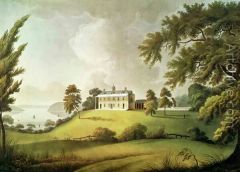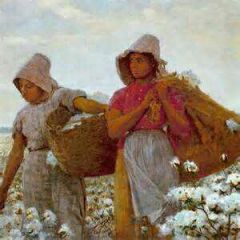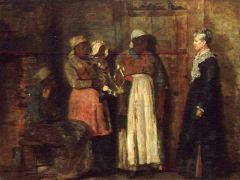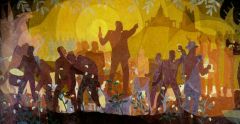![]()
![]()
![]()
Use LEFT and RIGHT arrow keys to navigate between flashcards;
Use UP and DOWN arrow keys to flip the card;
H to show hint;
A reads text to speech;
9 Cards in this Set
- Front
- Back

|
Francis Jukes Mount Vernon 1800 -stereotypical plantation -prints made available for middle class -house is peaceful with almost no evidence of slavery -stable and orderly |
|

|
Winslow Homer Cotton Pickers 1876 -greenish tint to field of cotton -the cotton seems to engulf the women -unable to escape their oppressed lives |
|

|
Winslow Homer A Visit from an Old Mistress 1876 -lady master -black women outnumber -seem to be backed into a corner -the visit is ambiguous |
|

|
Aaron Douglas Aspects of Negro life: From Slavery through Reconstruction 1934 -evoking plantation as setting -prominent moments of black life good and bad: reading of the emancipation proclamation and shadow of kkk. |
|
|
Liberty Displaying the Arts and Sciences |
Samuel Jennings, 1792- done by white northerner- commissioned for free library- white Savior- knowledge conquers slave shackles- black ppl kneeling and pleading in front of liberty- ambiguous setting- dominance of white authority. - done by white northerner- commissioned for free library- white Savior- knowledge conquers slave shackles- black ppl kneeling and pleading in front of liberty- ambiguous setting- dominance of white authority. - black ppl kneeling and pleading in front of liberty - ambiguous setting - dominance of white authority. |
|
|
Portrait of a Gentleman |
Joshua Johnson, 1805-1810 -first known aa to paint fine art -self taught -white patrons were usually abolitionists -figure in center -subdued background -free blacks presented as distinguished middle class -competence since he could paint at same caliber as white painters -subjects were able to commission a work. |
|
|
Am I Not a man and a Brother? |
Patrick Henry Reason. 1839 -engraving -seems to be in prayer -white benefactors not shown but assumed -faces outward, most of his face, personalized -facial expression is tired and not reverent -clothed but ripped in places -landscape made him real and not an ideal -reason was a free black -attempt to talk about how blacks might not need a white benefactor -radical reversal of Hackwood. |
|
|
Phillis Wheatley |
Scipio Moorhead, 1773 -moorhead's paintings don't exist and possibly made this engraving -Phillis was a slave that was taught to read and write by owners. -composed own work -purchased immediately from slave shop -no one wanted to publish her work, had to publish in London -clothes resemble English aristocracy -shown doing her craft in oval framing. |
|
|
Cinqué |
Nathaniel Jocelyn, 1840 -portrait of powerful leader in Greek attire -not represented in violent or savage manner -3/4 pose, heroic looking, dignified -image commissioned by Robert Purvis -mezzotint print made of cinque for easy spread to public -art committee rejected image becAuse of controversy |

